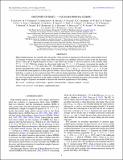Discovery of eight z~6 quasars from Pan-STARRS1
Author(s)
Banados, E.; Venemans, B. P.; Morganson, E.; Decarli, R.; Walter, F.; Chambers, K. C.; Rix, H.-W.; Farina, E. P.; Fan, X.; Jiang, L.; McGreer, I.; De Rosa, G.; Weiss, A.; Price, P. A.; Morgan, Jeffrey S.; Burgett, William S.; Greiner, J.; Kaiser, Nick; Kudritzki, R.-P.; Magnier, Eugene A.; Metcalfe, N.; Stubbs, C. W.; Sweeney, W.; Tonry, J. L.; Wainscoat, R. J.; Waters, C.; Simcoe, Robert A.; ... Show more Show less
DownloadBanados-2014-DISCOVERY OF EIGHT z.pdf (775.6Kb)
PUBLISHER_POLICY
Publisher Policy
Article is made available in accordance with the publisher's policy and may be subject to US copyright law. Please refer to the publisher's site for terms of use.
Terms of use
Metadata
Show full item recordAbstract
High-redshift quasars are currently the only probes of the growth of supermassive black holes and potential tracers of structure evolution at early cosmic time. Here we present our candidate selection criteria from the Panoramic Survey Telescope & Rapid Response System 1 and follow-up strategy to discover quasars in the redshift range 5.7 [< over ~] z [< over ~] 6.2. With this strategy we discovered eight new 5.7 ≤ z ≤ 6.0 quasars, increasing the number of known quasars at z > 5.7 by more than 10%. We additionally recovered 18 previously known quasars. The eight quasars presented here span a large range of luminosities (–27.3 ≤ M [subscript 1450] ≤ –25.4; 19.6 ≤ z [subscript P1] ≤ 21.2) and are remarkably heterogeneous in their spectral features: half of them show bright emission lines whereas the other half show a weak or no Lyα emission line (25% with rest-frame equivalent width of the Lyα +N V line lower than 15 Å). We find a larger fraction of weak-line emission quasars than in lower redshift studies. This may imply that the weak-line quasar population at the highest redshifts could be more abundant than previously thought. However, larger samples of quasars are needed to increase the statistical significance of this finding.
Date issued
2014-06Department
Massachusetts Institute of Technology. Department of Physics; MIT Kavli Institute for Astrophysics and Space ResearchJournal
Astronomical Journal
Publisher
IOP Publishing
Citation
Bañados, E., et al. “DISCOVERY OF EIGHT z ∼ 6 QUASARS FROM Pan-STARRS1.” The Astronomical Journal, vol. 148, no. 1, June 2014, p. 14. © 2014 The Astronomical Journal
Version: Final published version
ISSN
0004-6256
1538-3881